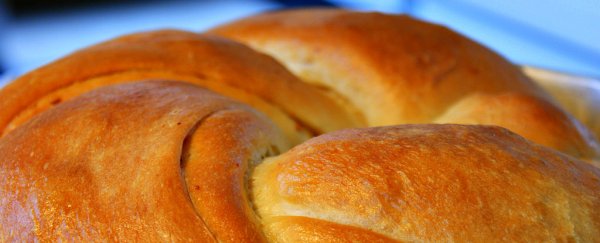Two food scientists have reportedly figured out how to isolate a corn protein that has the ability to make gluten-free bread and pasta as soft and doughy as their wheat-filled counterparts.
Despite the increase in people choosing a gluten-free diet these days - whether it's because of gluten sensitivity or lifestyle reasons - there's still a huge gap in the market for wheat-free baked goods and pastas that don't, let's face it, have the texture of a barely moist sponge.
Gluten, for all the hype surrounding it, is just a protein, which is found in wheat, rye, and barley. What's unique is its ability to form an 'elastic network' when kneaded with water. It also holds onto CO2 during fermentation, and that helps make our baked goods like brioche and baguettes all fluffy and soft on the inside.
Lots of other cereals and grains, such as buckwheat and rice, can be successfully used to make bread and pasta, but although they taste fine, they just never quite compare to the flavour and texture of wheat products. Which is where this new research comes in.
Two Italian food scientists, Virna Cerne and Ombretta Polenghi, from nutritional research company Dr. Schär, have found a cheap and easy way to isolate a protein in corn called zein, which has the ability to form a similar elastic network to gluten.
"Today the gluten-free products include a lot of fibre but the fibre cannot be really elastic," Cerne told Quartz. "Once the zein protein is isolated, it can be added to different gluten-free flours like rice or corn flour and it solves the problem of no elasticity."
Zein has been on the scene for ages, and is already used in a range of manufacturing processes. Scientists knew about its springy, elastic properties, but the problem was that it was incredibly expensive to produce, despite the wide availability of corn, and so no one had really considered it an alternative to gluten in the past.
But three years ago, Cerne and Polenghi's team discovered an isolation method that simply requires mixing corn flour with water and alcohol. Their technique means they can now extract zein en masse, and could one day even make zein-based products even more affordable than wheat ones in the future (which would be pretty exciting for gluten-free fanatics who are used to paying top dollar).
The research duo, along with their team, have now been awarded the European Inventor Award by the European Patent Office, and, as you probably guessed from that governing body, they've been awarded a patent for their zein extraction process.
The process itself is still in the research and development phase, and isn't ready to be scaled up just yet, but the team says they've been adding their extracted zein into baked goods and have been able to recreate the taste and texture of several types of breads.
For now, no peer-reviewed papers have been published on the taste and composition of these products - but there have been several papers by a range of teams over the past decade showing the chemical similarities between zein and gluten. One even showed that zein could be used to improve gluten-free sorghum bread.
Still, we're taking the researchers' word for exactly how this new extraction process works the moment, and seeing as they plan to commercialise the product, it's unlikely they're going to want to give away too many secrets any time soon.
But they told Rosie Spinks from Quartz that they're taking the tasting process very seriously.
"We taste gluten-free products 10 times a day," said Polenghi. "We are very organised in terms of what we call 'sensory evaluation', with a panel of ten taste-tasters who give an objective evaluation of our products' softness, crunchiness of crust, dimensions, cereal aroma, sourness, saltiness, and sweetness. We want people to enjoy our food."
We can't wait for more information - and taste tests - to become available. Speaking of, where's our bacon-flavoured seaweed at?
